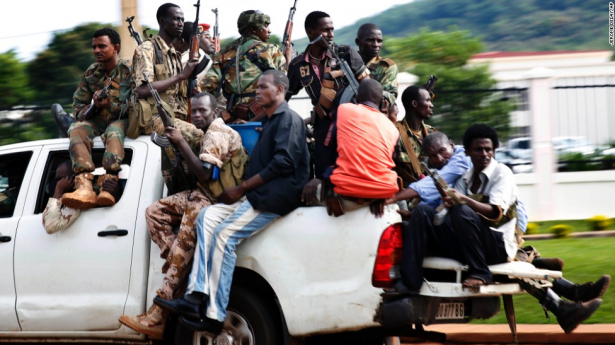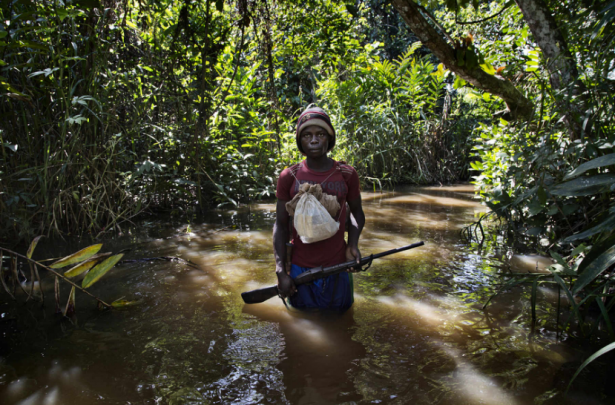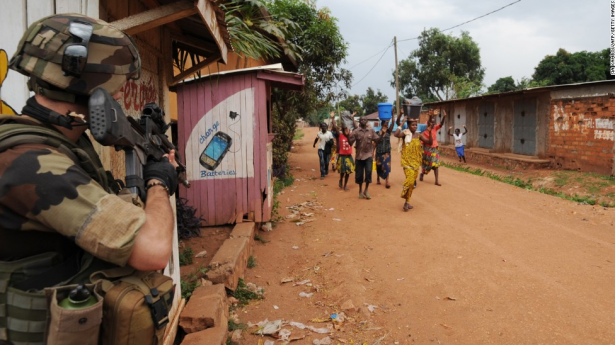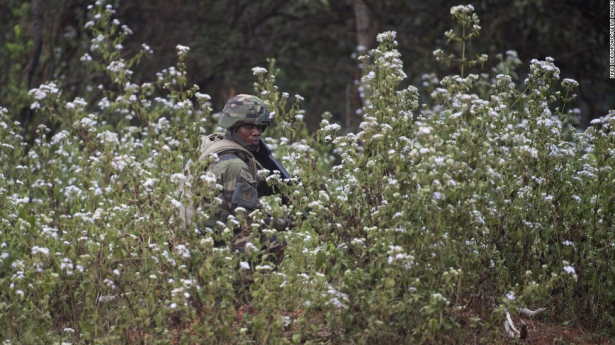
Seleka soldiers race through Bangui as gunfire and mortar rounds erupt in the capital December 5. (photo via CNN)
In recent weeks, the world has started to take notice of the urgent crisis unfolding in the Central African Republic (CAR). Following months of widespread atrocities against civilians and an explosion of humanitarian need, mainstream media outlets finally started talking about the escalating violence in CAR, which some UN officials have warned could lead to genocide. Even Buzzfeed took a break from its normal pop-culture GIFs to highlight the crisis last week.
Invisible Children has been monitoring the situation very closely with the help of our very brave staff on the ground in CAR and our advocacy team in Washington, DC. As an organization founded on a belief in the inherent and equal value of all human life, and as a community that wants to help build a world where genocide and mass atrocities no longer exist, the crisis in CAR is something we all should be learning about, talking about, and seeking to help end.
That said, we wanted to give you a rundown of what’s been happening in CAR, how it relates to the LRA, and what we’re been doing about it.

(Photo via Marcus Bleasdale)
How did the crisis start?
The CAR crisis has deep roots in the country’s turbulent history and cycle of coups and power grabs. Most recently, a rebel coalition called Séléka launched an offensive from the northeastern region of CAR in late 2012 with the aim of toppling the government of President François Bozizé. Séléka, which means “alliance” in the Central African national language of Sango, has been a loosely-connected coalition of several rebel groups — including a large number of mercenaries from neighboring Chad and Sudan – that unified under the common desire to oust President Bozizé and claim positions of power in a newly-formed government.
By March 2013, after a failed peace agreement, Séléka had taken over the CAR capital of Bangui, President Bozizé fled the country, and one of the leaders of Séléka, Michael Djotodia, declared himself the new leader of CAR. Along the way, Séléka fighters, many of them Muslim, carried out terrible acts of violence against civilians, including targeted attacks against Christians. While the media has often portrayed these attacks as religious in nature, it’s more accurate to describe them as sectarian violence, as the identities of these communities are very complex and shouldn’t be oversimplified as simply Christian vs. Muslim.
After accomplishing the one thing that had unified it — overthrowing Bozizé — Séléka lost cohesion, and violence against civilians escalated dramatically as heavily-armed, undisciplined Séléka rebels roamed freely through the capital and countryside, using violence to accomplish their own agendas. Many Séléka forces looted and burned villages, raped women, and killed scores of civilians.
Why have things gotten worse?
By October, after months of violence and intimidation at the hands of Séléka rebels (now referred to as “ex-Séléka”, because Djotodia officially dissolved the coalition), and with very little protection from African peacekeeping forces, many Central African communities started forming self-defense militias called anti-balaka groups, which in Sango means “anti-machete.” In addition to fighting back against ex-Séléka rebels, some anti-balaka groups, which are predominantly Christian, also have committed targeted attacks and killings of Muslim civilians, presuming that they were sympathizers of the largely Muslim ex-Séléka rebels. As a result of these reprisal attacks, many ex-Séléka have intensified targeted attacks on some Christian civilians, associating them with anti-balaka groups.
In early December, anti-balaka fighters launched an unexpected, coordinated attack against ex-Séléka in Bangui, which ignited several days of intense violence between the armed groups and against civilians – with some incidences of anti-balaka groups targeting Muslim communities and some ex-Séléka groups targeting Christian communities. Horrific stories have surfaced from Bangui and surrounding areas of both anti-balaka and ex-Séléka groups invading communities assumed to be loyal to the “other side,” and systematically going door-to-door, killing male family members, including young children.
More than 500 deaths were reported just from last week’s surge of violence in the capital – with attacks and killings still occurring in parts of Bangui and the countryside. Additionally, hundreds of thousands of civilians are displaced and in desperate need of security and humanitarian assistance.

People walk by a French soldier standing guard during a disarmament operation in Bangui on December 9. (Photo via CNN)
How has the international community responded?
Generally speaking, international governments have been shamefully slow in responding to the crisis in CAR, but there has been an uptick in attention and action over the last few months — and especially in the last week. Here’s a brief rundown of some of the most significant things that some international players have done so far:
Central African countries: Since earlier 2013, African peacekeeping forces, made up of troops from different Central African countries, have had a presence in and around Bangui with the purpose of protecting civilians and helping to stabilize the country. However, these forces have been too small in number and under-resourced to truly be effective in quelling ex-Séléka rebels and anti-balaka militias.
African Union: The African Union has committed to deploy a new peacekeeping force called MISCA, which is supposed to be 6,000 troops strong. MISCA forces have been gradually deploying into CAR over the past few days.
United Nations: On December 5th, the United Nations passed a resolution authorizing MISCA and French troops assisting MISCA to use force to protect civilians in CAR. The resolution also imposed an arms embargo on CAR, and hinted that the United Nations may eventually transition the AU mission into a United Nations peacekeeping operation down the road.
France: For several months, France had about 600 troops in CAR, its former colony, that were focused specifically on securing the airport in Bangui. Last week, France deployed an additional 1000 troops to CAR to support the MISCA peacekeeping mission. On December 10, President Hollande traveled to Bangui, less than 24 hours after reports confirmed two French soldiers had been killed by CAR armed groups.
United States: The United States has been very quiet on the CAR situation until just recently. In late November, the State Department announced that it would provide $40 million in logistical support to MISCA and later expressed strong support for the UN resolution authorizing the use of force for AU and French peacekeepers. In the last couple of days, President Obama recorded a message to the people of CAR and also authorized an additional $60 million in US logistical support to MISCA.

A French soldier watches the road in Baoro on Saturday, December 7. (Photo via CNN)
How does this relate to LRA violence in CAR?
While the Séléka-related conflict in CAR and LRA violence in CAR are generally two separate issues, there are several important connections between the two that we, and our political leaders, must be aware of. Here are three:
1. Kony will take advantage of chaos in CAR. Kony has a very predictable history of looking for safe havens when the pressure is on. Right now, African Union forces, supported by US advisors, are becoming increasingly effective at locating and tracking the LRA – putting increased pressure on Kony and his commanders. However, if CAR continues to descend into chaos and even further instability, this could provide a very welcoming safe haven for Kony and other LRA leaders.
2. The most LRA violent attacks are in (ex) Séléka-controlled areas. Currently, African Union and US forces are authorized to operate in the southeast corner of CAR known as Haut-Mbomou. As as result, LRA movement and attacks in this area have declined. However, several LRA groups have moved west and north in CAR, and are committing their most brutal attacks in areas outside of Haut-Mbomou where the AU and US do not currently have permission to operate. These are also areas where ex-Séléka rebels are prevalent, but there are no legitimate security forces present to protect civilians from violence – whether it be from the LRA, ex-Séléka, or anti-balaka. There must be coordination between MISCA forces soon to enter these areas and the African Union forces working to address the LRA, to ensure that civilians in areas further west and north of Haut-Mbomou are protected from attacks by all of these armed groups.
3. AU and US forces have helped protect civilians from Séléka. While they are exclusively focused on the LRA, the presence of Ugandan AU forces and US advisors in Haut-Mbomou has served as a strong deterrent for ex-Séléka rebels. Unlike the rest of the country, communities in the southeast corner of CAR have been spared from violence by ex-Séléka fighters. If the Ugandan and American forces were to withdrawn any time soon, however, it is likely that communities in this region would then fall prey to similar violence and chaos taking place in the rest of the country.

(Photo via Marcus Bleasdale)
What is Invisible Children doing?
As Invisible Children continues to support peace and security in CAR by working with local communities toward an end to LRA violence, we also continue to look for ways to help seek an end to the crisis plaguing the rest of the country. Here are a few specific things we’ve done over the past month, together with other organizations:
+ Hosted local civil society leaders from CAR on an advocacy trip to Washington, and organized meeting for them with U.S. government officials.
+ Signed a joint NGO statement, urging the U.S. government to develop a comprehensive strategy on CAR.
+ Signed a joint NGO letter to senior White House officials, including Susan Rice, urging President Obama’s new Atrocities Prevention Board to mobilize action on the CAR situation.
+ Continue to provide helpful information about the situation in Bangui, collected by our IC-CAR staff, to US government officials and other advocacy organizations in DC and New York.
What can you do?
For now, keep staying informed. Organizations like International Crisis Group, Human Rights Watch, and Doctors Without Borders are providing regular, credible information on the situation. We are working closely with other organizations in Washington, DC, and New York, exploring what else Invisible Children can do to help effectively address the situation in CAR. There’s a chance we may call on you to raise your voices and engage your policymakers about the situation in CAR….so stay tuned.
Think people should hear about this?